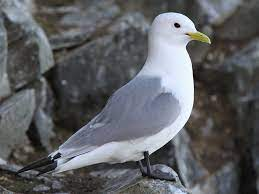An 1892 visit to the Bull Rock to collect seabirds' eggs
We cast off from the pier at
Berehaven on May 11 at 5am, and with smooth water and just enough wind to create
a draught on our furnace and a strong ebb tide in our favour, we were soon
alongside the Bull Rock, a small islet lying about two and a half miles N.W. of
Dursey Island and 292 feet high. This is the most southerly breeding haunt of
the gannet on the Irish coast.
There is deep water close to the rock and in fine weather a small steamer may lie close in to a remarkable arched hole worn by the action of the sea through the island. A good view of the buildings on the east side may be obtained and the effect of the view under the almost perpendicular cliff is somewhat heightened by the probability that some of the loose stones, which jut out here and there from the face of the rock, will one day fall from their places into the abyss below.
After landing a few tons of coal for
the use of the lightkeepers, I took one of the men with me and went ashore in
search of sea birds’ eggs. The ascent is not difficult, there being concrete
steps built all the way up to the lighthouse, but the moment we arrived at the
summit, a cold, clammy wind blew in our faces, with a fine rain that penetrated
our clothing and made our foothold very slippery and difficult. A thick fog
prevailing at the time, the watchman on the look-out station was busy with the
fog-signal – charges of gun cotton, which he fired at short intervals – the concussion
from which was very considerable at close quarters. We were informed by one of
the keepers that the nearest way to the gannets’ nesting places was close past
the signal station. Just as we were passing it, one of the charges was fired,
and within a few feet of us; the concussion was so great that it nearly knocked
us down. I shall never forget the look of dismay on Pat’s face as he crossed
himself and said “Oh Blessed Virgin, but they’ll blow us into smithereens. For the
love of God, sor, come away out of this.”
1905 CIL photograph in the National Library Ireland
The weather now cleared up and became
beautifully fine and warm, and we were able to obtain a good view from the
summit. The lightkeepers’ dwellings, with the lighthouse, signal station and
gasometer, with thousands of seafowl, some circling overhead, but the majority
sitting on their nests, gave the rock a very homely and animated appearance
compared to what it was when I visited it some years ago, before these buildings
were erected.
During the breeding season the birds
are very tame. The puffins seem to have no fear whatever, though wary enough
when on the water and away from their nests. We captured several of them with a
landing net, but let them go again. I have sat for hours within a few feet of
these birds, making sketches of them and no better place could an artist find
for studying the habits and attitudes of sea birds than this wild, rocky isle
off the Irish coast.
The puffins and razorbills seem to
keep on friendly terms enough with one another but will not permit the gannets
or seagulls to associate with them. I have watched the puffins and razorbills
sitting side by side in the most friendly manner. The puffins, with their
furrowed and painted beaks, remind one strongly of the highly coloured
pasteboard noses of preponderous shape and size which decorate the windows of
the toy shops at Christmas time; this, with their look of utter indifference,
strike one as very laughable. For pugnacity and impudence, a town-bred
cock-sparrow is difficult to beat, but for a look of thorough contentment and
utter indifference to all surroundings, commend me to a puffin on the Bull
Rock.
1905 CIL photograph in the National Library Ireland
We made a good collection of eggs,
the gannet, puffin, razorbill and kittiwakes being very plentiful, but
difficult to get at; one has to stick as close to the rock as a limpet when
creeping along the narrow ledges of the precipices, only a few inches wide.
This is very dangerous work to one not accustomed to it, as a false step, or a
loose stone, will end your egg-collecting days forever in this world. It was
only a few weeks ago one of the light-keepers on the Tearaght, one of the
Blasket group of islands off the Kerry coast, lost his life while collecting ‘sea-parrot’s’
eggs. He was on a very dangerous part of the rock at the time, and was in the
act of taking a puffin’s egg, when the bird, which happened to be in the hole
at the time, bit his finger and, in suddenly pulling back his hand, he overbalanced
himself and fell backwards, rolling down some 50 feet of the sloping part of
the rock, and then disappeared over the precipice some 400ft into the sea
below. His body was never recovered.












Talk about taking yer life in yer hand Pete, and literally in the case of youn light keeper
ReplyDeleteVery unfair of you to blame that actual puffin for the murder.
ReplyDeleteHe/She looks blameless to me…